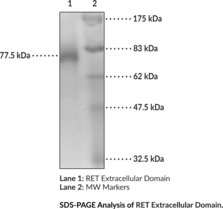Territorial Availability: Available through Bertin Technologies only in France
- Correlated keywords
- CDHF-12 CDHR-16 RET-51 PTC GFR?2 GFR?3 GFR?4 GFR?-1 2 3 4
- Product Overview:
Rearranged during transfection (RET) is a receptor tyrosine kinase with roles in cell proliferation, survival, metabolism, and migration, as well as in the development of the peripheral and central nervous systems.{60954,60955} It is composed of an extracellular domain, containing four cadherin-like domains (CLDs), a calcium-binding site, and a cysteine-rich region, a transmembrane domain, and an intracellular kinase domain.{60954,60956} RET forms heterodimeric complexes with the glial cell line-derived neurotrophic factor (GDNF) ligands GDNF, neurturin (NRTN), artemin (ARTN), and persephin (PSPN), and the GDNF family co-receptors GFR?1-4, which induces autophosphorylation of the intracellular kinase domain and activates cellular signaling.{60956} Germline nonsense and/or missense mutations in RET decrease functional RET in gut tissue during development and are associated with Hirschsprung’s disease.{60954,60956} Loss-of-function mutations in RET are associated with congenital anomalies of the kidney and urinary tract (CAKUT) and renal agenesis.{60956} Gain-of-function mutations in RET are associated with medullary thyroid cancer, pheochromocytoma, and parathyroid hypoplasias, and RET gene fusions have been found in patients with lung, colon, or breast carcinomas.{60955,60956} Cayman’s RET Extracellular Domain (human, recombinant) protein can be used for enzyme activity assays.
Cayman Chemical’s mission is to help make research possible by supplying scientists worldwide with the basic research tools necessary for advancing human and animal health. Our utmost commitment to healthcare researchers is to offer the highest quality products with an affordable pricing policy.
Our scientists are experts in the synthesis, purification, and characterization of biochemicals ranging from small drug-like heterocycles to complex biolipids, fatty acids, and many others. We are also highly skilled in all aspects of assay and antibody development, protein expression, crystallization, and structure determination.
Over the past thirty years, Cayman developed a deep knowledge base in lipid biochemistry, including research involving the arachidonic acid cascade, inositol phosphates, and cannabinoids. This knowledge enabled the production of reagents of exceptional quality for cancer, oxidative injury, epigenetics, neuroscience, inflammation, metabolism, and many additional lines of research.
Our organic and analytical chemists specialize in the rapid development of manufacturing processes and analytical methods to carry out clinical and commercial GMP-API production. Pre-clinical drug discovery efforts are currently underway in the areas of bone restoration and repair, muscular dystrophy, oncology, and inflammation. A separate group of Ph.D.-level scientists are dedicated to offering Hit-to-Lead Discovery and Profiling Services for epigenetic targets. Our knowledgeable chemists can be contracted to perform complete sample analysis for analytes measured by the majority of our assays. We also offer a wide range of analytical services using LC-MS/MS, HPLC, GC, and many other techniques.
Accreditations
ISO/IEC 17025:2005
ISO Guide 34:2009
Cayman is a leader in the field of emerging drugs of abuse, providing high-purity Schedule I-V Controlled Substances to federally-licensed laboratories and qualified academic research institutions for forensic analyses. We are certified by ACLASS Accreditation Services with dual accreditation to ISO/IEC 17025:2005 and ISO Guide 34:2009.





